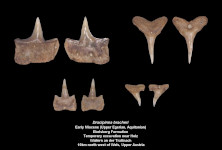Dracipinna bracheri
Pollerspöck & Straube, 2021
Classification: Elasmobranchii Squaliformes Dalatiidae
Reference of the original description
Phylogenetic placement and description of an extinct genus and species of kitefin shark based on tooth fossils (Squaliformes: Dalatiidae). Journal of Systematic Palaeontology, 19(15), 1083–1096
Phylogenetic placement and description of an extinct genus and species of kitefin shark based on tooth fossils (Squaliformes: Dalatiidae). Journal of Systematic Palaeontology, 19(15), 1083–1096
Synonyms / new combinations and misspellings
Bracheria wallernensis, Bracheria wallerniensis
Bracheria wallernensis, Bracheria wallerniensis
Types
Dracipinna bracheri
Holotype: NHMW: 2020/0001/0024; Paratype: NHMW: 2020/0001/0002; NHMW: 2020/0001/0007; NHMW: 2020/0001/0008; NHMW: 2020/0001/0009; NHMW: 2020/0001/0018;
Dracipinna bracheri
Holotype: NHMW: 2020/0001/0024; Paratype: NHMW: 2020/0001/0002; NHMW: 2020/0001/0007; NHMW: 2020/0001/0008; NHMW: 2020/0001/0009; NHMW: 2020/0001/0018;
Description:
Citation: Dracipinna bracheri Pollerspöck & Straube, 2021: In: Database of fossil elasmobranch teeth www.shark-references.com, World Wide Web electronic publication, Version 04/2024
Please send your images of "Dracipinna bracheri" to info@shark-references.com

Dracipinna bracheri Pollerspöck & Straube, 2022, image of the first description, some types, upper ans lower jaw teeth © Jürgen Pollerspöck

Dracipinna bracheri Pollerspöck & Straube, 2022, image of the first description, some types, upper ans lower jaw teeth © Jürgen Pollerspöck
Description
Original diagnose after Pollerspöck & Straube, 2021 [30449]: The most frequent dentition in extant squaliform sharks is dignathic heterodont. We conclude that a strongly developed dignathic heterodonty as well as a disjunct monognathic heterodonty was present in the genus, but weaker than in other members of the clade. Upper jaw teeth are single-cusped; cusp (with exception of posterior or commissural teeth) slender, erected, nearly symmetrical, biconvex and comprising nearly two-thirds of tooth height; cutting edges always of different lengths, mesial always shorter than distal, never reaches the base of the cusp; posterior or commissural teeth strongly inclined distally with a low distal heel and straight mesial cutting edge; no ornamentation present; no apron present; labial usually no ridges at the base of the cusp; two root lobes, root low with short and rounded lobes, one central lingual foramen present, labial several foramina present. The teeth strongly resemble upper jaw teeth of extant dalatiid species. In contrast to the upper jaw teeth, lower jaw teeth are labiolingually compressed and show areas of overlap onto former neighbouring teeth; they are single cusped, with the exception of posterior or commissural teeth, broad, erected, convex mesial and strongly concave distal, continuous cutting edges, low straight or upturned distal heel present, distal cutting edge divided from distal heel by a notch, posterior or commissural teeth strongly inclined distally with a low distal heel and concave mesial cutting edge; no ornamentation present; no serration present, lingual base of enameloid straight, labial base of enameloid wavy, rectangular root, lingual basal groove absent, lingually one central foramen present, distally one large central foramen and several smaller foramina present, overlapping area to adjacent teeth present.
Original diagnose after Pollerspöck & Straube, 2021 [30449]: The most frequent dentition in extant squaliform sharks is dignathic heterodont. We conclude that a strongly developed dignathic heterodonty as well as a disjunct monognathic heterodonty was present in the genus, but weaker than in other members of the clade. Upper jaw teeth are single-cusped; cusp (with exception of posterior or commissural teeth) slender, erected, nearly symmetrical, biconvex and comprising nearly two-thirds of tooth height; cutting edges always of different lengths, mesial always shorter than distal, never reaches the base of the cusp; posterior or commissural teeth strongly inclined distally with a low distal heel and straight mesial cutting edge; no ornamentation present; no apron present; labial usually no ridges at the base of the cusp; two root lobes, root low with short and rounded lobes, one central lingual foramen present, labial several foramina present. The teeth strongly resemble upper jaw teeth of extant dalatiid species. In contrast to the upper jaw teeth, lower jaw teeth are labiolingually compressed and show areas of overlap onto former neighbouring teeth; they are single cusped, with the exception of posterior or commissural teeth, broad, erected, convex mesial and strongly concave distal, continuous cutting edges, low straight or upturned distal heel present, distal cutting edge divided from distal heel by a notch, posterior or commissural teeth strongly inclined distally with a low distal heel and concave mesial cutting edge; no ornamentation present; no serration present, lingual base of enameloid straight, labial base of enameloid wavy, rectangular root, lingual basal groove absent, lingually one central foramen present, distally one large central foramen and several smaller foramina present, overlapping area to adjacent teeth present.
References

Phylogenetic placement and description of an extinct genus and species of kitefin shark based on tooth fossils (Squaliformes: Dalatiidae). Journal of Systematic Palaeontology, 19(15), 1083–1096
DOI: 10.1080/14772019.2021.2012537

Phylogenetic placement and description of an extinct genus and species of kitefin shark based on tooth fossils (Squaliformes: Dalatiidae). Journal of Systematic Palaeontology, 19(15), 1083–1096
DOI: 10.1080/14772019.2021.2012537
Haie im Alpenvorland - Fossile Zeugen eines verschwundenen Paradieses. Verlag Anton Pustet, Salzburg, ISBN-10: 3702510230

Pisces. In PILLER, W.E.(Ed.) Catalogus Fossilium Austriae, Band 3 - Verlag der Österreichischen Akademie der Wissenschaften, Wien, ISBN13: 978-3-7001-7238-3, 576 pp.

Wallern - ein bedeutender Mosaikstein für die Evolution der Fische. Festschrift zur Markterhebung der Germeinde Wallern, 1984, 6–8

Phylogenetic placement and description of an extinct genus and species of kitefin shark based on tooth fossils (Squaliformes: Dalatiidae). Journal of Systematic Palaeontology, 19(15), 1083–1096
DOI: 10.1080/14772019.2021.2012537

Phylogenetic placement and description of an extinct genus and species of kitefin shark based on tooth fossils (Squaliformes: Dalatiidae). Journal of Systematic Palaeontology, 19(15), 1083–1096
DOI: 10.1080/14772019.2021.2012537
Haie im Alpenvorland - Fossile Zeugen eines verschwundenen Paradieses. Verlag Anton Pustet, Salzburg, ISBN-10: 3702510230

Pisces. In PILLER, W.E.(Ed.) Catalogus Fossilium Austriae, Band 3 - Verlag der Österreichischen Akademie der Wissenschaften, Wien, ISBN13: 978-3-7001-7238-3, 576 pp.

Wallern - ein bedeutender Mosaikstein für die Evolution der Fische. Festschrift zur Markterhebung der Germeinde Wallern, 1984, 6–8


















